Message from the Director in Charge of the Environment

As a specialized seat manufacturer whose mainstay product is automotive seats, TACHI-S works across the globe to
provide safe, comfortable mobility spaces. As such, we are highly conscious of the growing expectations and
demands on the automotive industry around the globe to be considerate of the environment.In particular, reducing
greenhouse gas emissions by reducing the fuel consumption of automobiles by reducing the weight of products and
reducing the energy use of the manufacturing process of products, and contributing to a recycling-oriented society
by saving resources and a low-carbon society by saving energy. We believe that this is not only an important area
of contribution that we can work on to solve global environmental problems, but also a strategic theme that is
directly linked to improving the competitiveness of our products in response to customer requests.
For the realization of a sustainable mobility society, TACHI-S, together with its stakeholders, will strive to
continuously reduce the environmental impact of its products and business activities. The entire TACHI-S Group
will promote environmental conservation activities to ensure a global environment where future generations can
live happily.
Yoshiaki Kubo,
Director and Executive Managing Officer
in Charge of the Environment
Environmental Policy
In the belief of the importance of passing on our precious global environment to future generations and of promoting
Group-wide activities for environmental conservation to realize a society in which people and nature can coexist,
TACHI-S established its Environmental Policy in 2000. This policy clearly states the key areas of TACHI-S’s
environmental activities, including compliance with environmental laws and regulations, the reduction of greenhouse
gas emissions, and the development of environmentally-friendly products.
1. Basic Philosophy
A company that is kind to people and nature
Setting “kindness,” or consideration of people, society, and nature, as the foundation of its
manufacturing,
TACHI-S will raise all employees’ correct awareness of the environment and commit proactively to the
protection of
the global environment, to contribute to the realization of a rich society in which people and nature can co-exist.
2. Environmental Policy
In all business activities related to development, design engineering, purchasing, and production of automotive
seats and related components, TACHI-S will promote periodic reviews of its activities to achieve the environmental
goals and targets and environmental management system established by the Company, and reduce our environmental
impact.
- (1)We will comply with environment-related laws and regulations, ordinances,
agreements, and industry standards and regulations in Japan and overseas to prevent environmental pollution.
- (2)We will promote the reduction of greenhouse gas emissions by improving efficiency
through the continuous improvement of business operations.
- (3)We will strive to develop environmentally friendly products and methods and
reduce our use of hazardous chemicals by transitioning to alternative substances.
- (4)We will promote the conservation of resources and energy, strive for a proactive
co-existence with local communities, and aim toward full employee participation in environmental protection
activities by raising the environmental awareness of each employee.
Environmental Management Structure
System for Promotion of Environmental Conservation Activities
To promote company-wide environmental conservation activities, TACHI-S established the Company Environment Management
Committee (Secretariat: General Affairs Department), with the Executive Managing Officer serving as chair, the
individual Division Managers as deputy chairs, and representatives of the individual locations as members. This
committee, which meets quarterly, manages environmental protection activities at Headquarters and individual
plants.
Three specialist subcommittees also engage in activities on different topics.
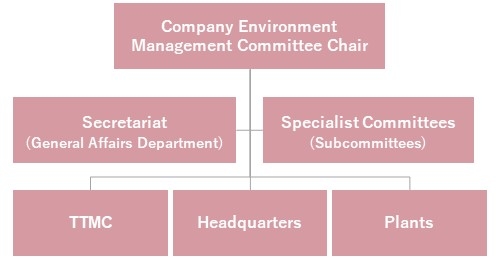
Environmental Management System
TACHI-S introduced the ISO 14001 environmental management system in 2001 to continuously improve its environmental
conservation activities. Currently, eight locations, including headquarters, have obtained external certification.
Affiliated companies have acquired ISO 14001 external certification for environmental management systems at their main
bases in Japan, North America, China, and Thailand.
| TACHI-S |
- Headquarters
- Technical Monozukuri Center
- Aichi Plant
- Ome Plant
- Musashi Plant
- Tochigi Plant
- Hiratsuka Plant
- Suzuka Plant
|
Affiliated companies
*consolidated subsidiaries |
- TF-METAL U.S.A., LLC
- TACHI-S H&P Co., Ltd.
- Nui Tec Corporation
- SETEX Automotive Mexico, S.A. de C.V.
- Wuhan Dongfeng TACHI-S Yanfeng Automotive Seating Co., Ltd.
- TACLE Guangzhou Automotive Seat Co., Ltd.
- Hunan TACHI-S Automotive Seating Co., Ltd.
- TACHI-S Lear DFM Automotive Seating (Xiang yang) Co., Ltd.
- Lear Dongshi TACHI-S Automotive Seating (Wuhan) Co., Ltd.
- TACHI-S Automotive Seating (Thailand) Co., Ltd.
|
Environmental Education

Scene from environmental education program for new employees
Guided by the Environmental Policy, TACHI-S has established procedures for the education and training of
employees who are involved in environmental conservation activities and conducts systematic education and training
programs for the effective promotion of such activities. We also educate new employees on basic knowledge
regarding environmental conservation.
We encourage employees to participate in nature conservation activities in collaboration with NPOs and local
governments (Tokyo Greenship Action) to raise their awareness of the environment. These activities involve forest
thinning and felling, maintenance of service roads, and tree planting. Employees gain hands-on experience of
activities for the maintenance of a good, rich forest environment. Going forward, we will continue to enhance our
environmental education programs to raise employees’ environmental awareness.
Environmental Risk Management

Emergency response drill for a chemical leak at the Technical Monozukuri Center
Envisaging the environmental impacts of an emergency at one of its locations, TACHI-S has established procedures
for the prevention and mitigation of such impacts and conducts maintenance and management accordingly. Further,
envisaging an emergency situation caused by an actual accident, we also conduct emergency response drills
systematically.
Environmental Audit
For ISO14001, TACHI-S undergoes systematic internal audits and certification assessments by external specialized
institutions, to ensure that its environmental management system is being properly maintained and implemented. We also
conduct systematic training of internal auditors.
Status of implementation of environmental audits
Environmental Issues and Targets
Relationship between TACHI-S’s Business Activities and Environmental Impact
In the manufacture of automotive seats, TACHI-S uses metals for the base of the seat frame and non-metallic materials
such as urethane, fabrics, leathers, and plastics.
We also use electricity and other energy in our manufacturing processes. To minimize greenhouse gas emissions from our
production activities, we strive to reduce emissions, with a particular focus on processes with high energy
consumption such as frame welding. In terms of the use of water resources, we have adopted manufacturing processes
that use very little water, except for the cooling water used in certain equipment.
Material Environmental Issues
Identification of Material Environmental Issues
We consider “response to climate change issues,” “chemical management,” and
“sustainable use of resources” to be
material management issues that are closely related to our business activities and engage in initiatives to solve
these issues.
Material environmental issues
- Response to climate change issues (reduction of greenhouse gas emissions, adaptation to climate change)
- Chemical management (reduction of hazardous chemicals, prevention of environmental pollution)
- Sustainable use of resources (improvement of resource utilization efficiency, reduction of waste materials)
Environmental Risks and Opportunities
We recognize the following risks and opportunities of our business activities caused by material environmental
issues.
We believe that reducing these risks and responding appropriately to business opportunities will help to solve
environmental issues and enhance our corporate value.
TACHI-S’s environmental risks and opportunities
Environmental Targets and Achievements
- For the reduction of greenhouse gas emissions, we mainly worked to reduce CO2 emissions through
improvements to
day-to-day operations. In terms of equipment, we undertook a systematic conversion to LED lighting and energy-saving
air-conditioning equipment across the entire company. We also introduced equipment to make energy consumption
visible as a way of cutting down on wasteful power consumption. The achievement rate was 98.8% against the basic
unit ( per unit ) target for FY2022.
- For the reduction of harmful chemicals, we put initiatives in place that focused on the reduction of defects in
the integrated foaming process (process of producing urethane foam to form headrests, etc.), thus achieving our
FY2022 targets.
- For the reduction of final disposal waste (landfill waste), we implemented thorough waste separation and worked
with outsourced operators, resulting in a continued achievement of zero landfill waste since FY2014.
Annual environmental targets and results ( Domestic bases of TACHI-S )
* In calculating the basic unit, the CO2 conversion coefficient is fixed
so that
voluntary improvement can be evaluated.
* Non-recyclable waste is treated by thermal recycling, the result of which is the
achievement of zero final disposal waste, which equals zero emissions.
Climate Change Issues
Basic Concept and Approach
Global warming and the accompanying climate change are causing melting glaciers and rising sea levels, floods and
droughts, as well as impacts on human lifestyles and natural ecosystems, including land and marine ecosystems, food
production, and health. Amid calls for the reduction of greenhouse gases to prevent climate change, TACHI-S is working
to reduce CO2 emissions from driving (Scope 3) with the lightweighting of its seats and the reduction of
CO2 emissions
from its manufacturing processes (Scope 1 & 2).
Basic Policy on Climate Change Response
As its contribution to the various governments’ carbon neutrality goals, “Carbon Neutral in 2050*,”
TACHI-S has set a
new target for CO2 emissions reductions of 46% (domestic) compared to FY2013 in 2030 and 43% (overseas)
compared to
FY2019 in FY2030. In our plants and offices, we will engage in the reduction of CO2 emissions by cutting
down on
energy consumption through the promotion of energy conservation and shift to low-carbon energy, including the
introduction of renewable energies. We will also adopt and develop carbon-free raw materials to reduce CO2
emissions
across the lifecycle of our products and strive to reduce CO2 emissions throughout the entire supply chain.
* Production volume intensity target for Scope 1 & 2 in Japan
- We will engage in the reduction of CO2 emissions through energy conservation at our business locations,
day-to-day
improvements in production processes, and the transition to power-saving production equipment.
- We will engage in the reduction of CO2 emissions through changes in product specifications and
manufacturing
processes.
- We will promote the introduction of renewable energies.
- We will strive to reduce CO2 emissions throughout the entire supply chain.
- We will disclose information appropriately to Stakeholders.
Efforts to Prevent Climate Change
TACHI-S has set company-wide CO2 emissions reductions targets and continues to promote initiatives to
reduce
emissions. In addition to emissions reduction activities through day-to-day improvement activities, we also work to
reduce CO2 emissions intensity by production volume. Initiatives toward this goal include conversion to LED
lighting,
the introduction of energy-saving air-conditioning equipment, and the introduction of electric vehicles and
hydrogen-fueled vehicles for company fleets. In addition, in terms of renewable energy, solar power generation
equipment was installed at the Aichi Plant and Suzuka Plant in FY2022, and power generation was started.
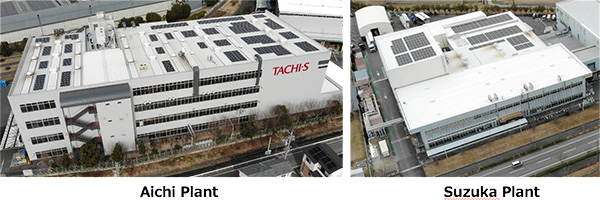
Trends in total energy consumption (Scope1 and 2)
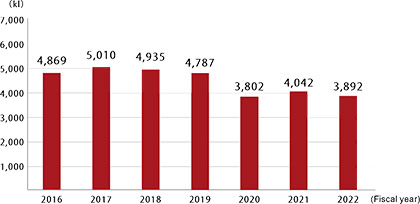
Trends in greenhouse gas emissions and greenhouse gas emission intensity (Scope1 and 2)
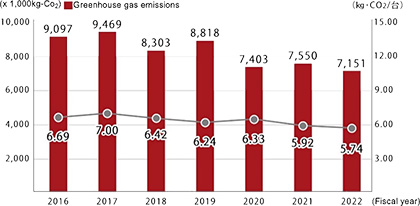
Trends in greenhouse gas emissions (By scope)
Greenhouse gas total emissions of Affiliated companies
Japan region *Except TACHI-S
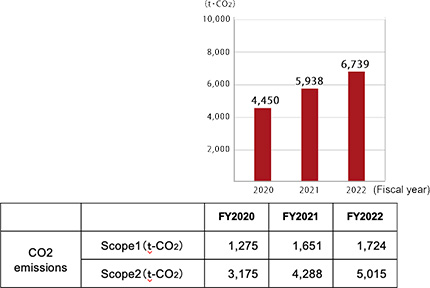
North America region
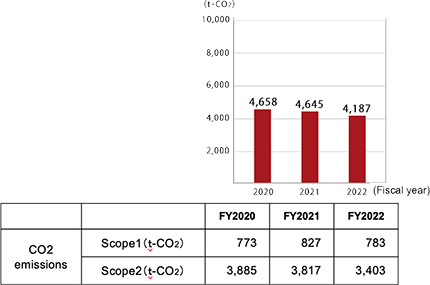
Latin America regions
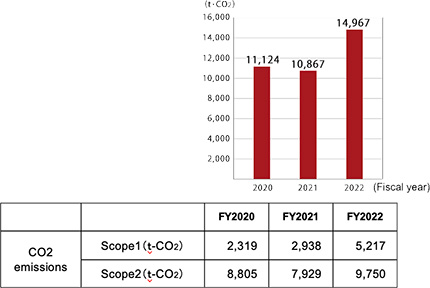
China region
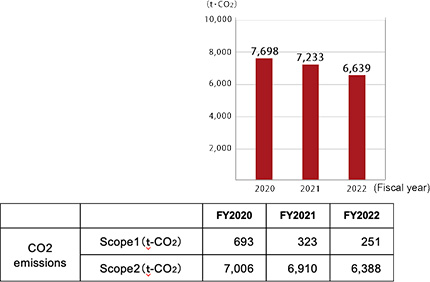
Asia region
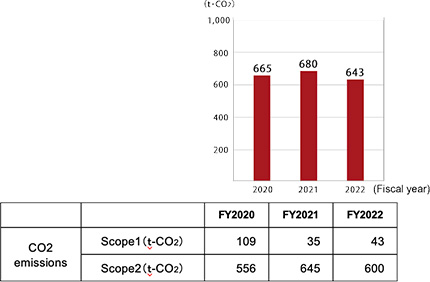
Efforts to Adapt to Climate Change
With the aim of adapting to climate change, as a measure to prepare for responses to natural disasters, which are
increasing in line with climate change, pocket disaster-prevention manuals have been distributed to employees. We are
also pursuing initiatives to minimize risks in the event of a disaster. They include basic actions to be taken in the
event of natural disasters, the establishment of a disaster readiness response headquarters, and a safety confirmation
system.
Efforts to Achieve a Circular Resources Economy
Basic Concept and Approach
Demand for natural resources such as fossil fuels and rare earths is expected to continue growing with future global
population increases and economic development. As a country that relies heavily on imports for its resources, for
Japan to continue to develop sustainably, it will need to create a circular economy for resources by further reducing
their consumption and improving the efficiency of their use.
TACHI-S uses raw materials such as iron, plastic, fabric, leather, urethane, and rubber in the development and
manufacture of automotive seats. We also purchase and use resources and energy such as packaging materials,
electricity, fuel, and water. We want to contribute to the realization of a circular resources economy by promoting
initiatives for the conservation of resources and energy.
Basic Policy on Conservation of Resources
With the aim of creating a circular economy that balances the environment and economy for the sake of sustainable
development, TACHI-S will work to use limited resources efficiently in the individual stages of development,
production, and disposal.
- We will work to reduce the size and weight of parts.
- We will strive to reduce waste by increasing yield and reducing defects in the manufacturing process.
- We will promote the use of renewable energies and recyclable resources.
- We will disclose information appropriately to Stakeholders.
Initiatives for the Conservation of Resources
TACHI-S undertakes initiatives for the conservation of resources in the development and production stages.
Specifically, development-stage initiatives include the lightweighting of seats (reducing weight through changes in
frame materials), cutting down on the number of component parts, and efforts to improve yield (minimizing offcuts when
cutting fabrics and leather).
In the production stage, we strive to reduce defects (reduction of defects in the integrated foaming process), and to
cut down on packaging materials (switch from one-way cardboard containers to re-usable plastic containers). In the
reduction of final disposal waste (landfill waste), we first achieved zero emissions* in fiscal 2014 and have
maintained that record every year since.
- ※Non-recyclable waste is treated by thermal recycling, the result of which is the
achievement of zero final disposal waste, which equals zero emissions.
Trends in total waste volumes
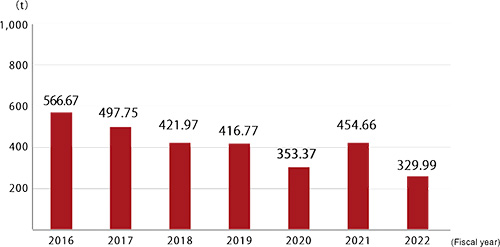
Trends in final waste disposal
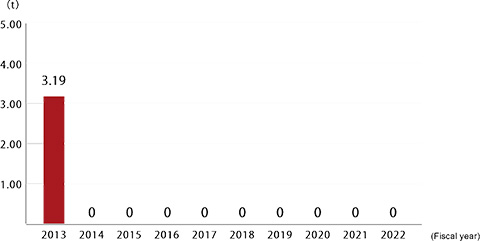
Water Resources Management
Basic Concept and Approach
With climate change due to global warming and the rapid population growth of recent years, the risk of shortages in
water resources is increasing in some regions. To use limited water resources wisely, we strive to reduce water usage
in our production processes, as well as saving water in our facilities in general.
Basic water resources policy
TACHI-S will work to effectively utilize limited water resources with the aim of creating a recycling-oriented
society that balances the environment and the economy for sustainable development.
- We will work on recycling water resources such as recycling cooling water and wastewater in the production
process.
- We will strive to reduce the amount of water used in the facility.
- We will monitor wastewater regularly and conduct appropriate wastewater treatment.
- We will disclose information appropriately to stakeholders.
Initiatives and Achievements in Water Resources Management
As a result of water saving efforts in our facilities, we achieved a 12% reduction year-on-year in water resource
input to 23,263 m3.The volume of wastewater output was the same as water resources input.
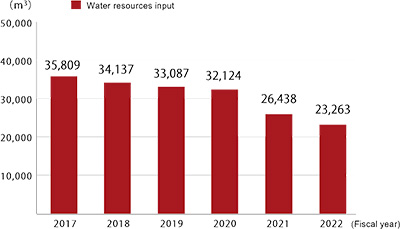
Trends in water resources input (TACHI-S business locations in Japan)
Chemical Management and Pollution Prevention
Basic Concept and Approach
Chemical substances discharged into the environment are potential causes of air pollution and water pollution. If
they accumulate in the soil over long periods of time, they may also adversely affect ecosystems and human health.
TACHI-S uses chemicals in the integrated foaming process and other processes. We promote initiatives for the proper
management of chemicals and the reduction of hazardous chemicals.
Basic Chemical Management Policy
Throughout the product lifecycle of development, production, purchasing, distribution, use, and disposal, TACHI-S
will properly manage and reduce the use of chemicals that are regulated under laws and regulations, ordinances,
agreements, and industry standards that apply in countries and regions where it conducts its business, for the
safety and peace of mind of customers, suppliers, and employees.
- In product development, we will identify the chemicals and their quantities in use, manage them properly, and
develop technologies for their reduction.
- We will identify the quantities of chemicals used in product manufacturing processes, manage them properly, and
reduce their use.
- We will identify the impact of chemicals in the sales and distribution processes and manage them properly.
- We will educate employees about the risks involved in the handling of chemicals and strive to make them aware of
the need for chemical management.
- We will disclose information appropriately to Stakeholders.
Initiatives and Achievements in Chemical Management
TACHI-S has designated the following chemicals contained in its products as managed chemical substances and strives
to manage them properly.
We are also working to reduce the quantities of chemicals used in production processes and
switching to alternatives with lower environmental impact.
Managed chemicals
Trends in handled (used) quantities of chemicals subject to PRTR legislation
Pollution Prevention
Efforts to Prevent Pollution
Due to the risk of chemicals polluting rivers, underground water, and soil, TACHI-S conducts tests and inspections to
prevent environmental pollution at individual locations, also performs emergency drills in a systematic manner.
Under the Water Pollution Prevention Act, we also regularly test wastewater discharged from individual locations into
public waters to confirm that we are satisfying environmental standards. TACHI-S has no facilities that lead to air
pollution and no incidences of soil pollution.
Environmental standards achievements for plant effluent
Preservation of Biodiversity
Basic Concept and Approach
Today, due mainly to the impact of human activity, species extinction on the Earth is occurring at a pace that is 100
to 1,000 times that of natural occurrence. Many living creatures are in danger of extinction and biodiversity is being
lost.
This is resulting in the degradation of biological services that support our abundant lifestyles and economic
activity, creating a demand for initiatives for the preservation of biodiversity on a worldwide scale.
Basic Policy on Biodiversity
Setting “kindness,” or consideration of nature, as the foundation of its manufacturing, TACHI-S will
strive to preserve biodiversity by reducing its impact on the global environment, with the aim of achieving a
sustainable society.
- We will identify the impacts of TACHI-S’s businesses on biodiversity.
- We will strive to reduce our impact on the global environment.
- We will pursue activities for the conservation of the natural environment.
- We will disclose information appropriately to Stakeholders.
Biodiversity Preservation Activities
To protect our precious natural environment, including forests in mountainous areas, traditional rural landscapes in
the hills, and brushwood in urban areas, we work with NPOs and local governments to engage in environmental
conservation activities.
In 2019, 40 TACHI-S employees participated in conservation activities in the Ome Kaminariki Forest Environment
Conservation Area in Tokyo.